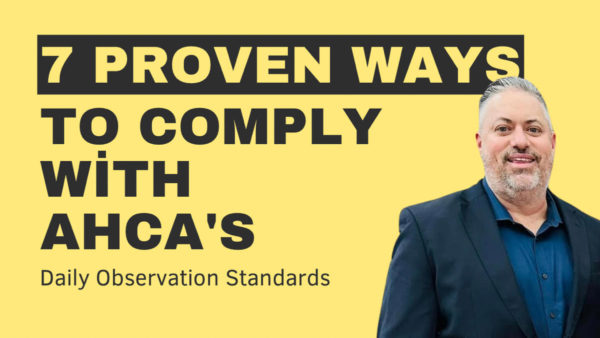
7 Proven Ways to Comply with AHCA’s Daily Observation Standards
Ensuring compliance with AHCA’s Regulation 59A-36.007 Resident Care Standards is crucial for the smooth operation of assisted living facilities. This regulation mandates daily observation by designated staff of the activities of residents while on the premises, along with awareness of their general health, safety, and physical and emotional well-being. Here are seven proven ways to meet these standards effectively, along with examples of what can happen if the regulation is not followed.
1. Designate Responsible Staff
Assign specific staff members to be responsible for daily observations. These individuals should be trained to recognize signs of health issues, emotional distress, and safety hazards. Having a clear chain of responsibility ensures accountability and thoroughness in resident care.
2. Develop Observation Protocols
Create standardized protocols for daily observations. These should include checklists or forms to ensure consistency and thoroughness. Protocols should cover key areas such as:
Daily activities (e.g., participation in social events, dining, exercise).
Health indicators (e.g., appetite, mobility, medication adherence).
Safety checks (e.g., fall risks, secure environment).
Emotional and psychological state (e.g., mood, social interactions).
3. Implement Daily Routine Checks
Schedule routine checks at various times throughout the day to monitor different aspects of the residents’ activities and well-being. This can be integrated into the daily schedule to ensure it becomes a habitual part of staff duties. Regular checks help in identifying and addressing issues promptly.
4. Use Technology for Monitoring
Utilize technology such as electronic health records (EHR) and monitoring devices to track and document observations. These tools can help maintain accurate and up-to-date records of each resident’s status, making it easier to spot trends and intervene when necessary.
5. Regular Staff Training
Conduct ongoing training for staff to ensure they are equipped with the skills needed to observe and document residents’ well-being effectively. Training should cover recognizing signs of physical and emotional changes, proper documentation practices, and effective communication techniques. Continuous education helps in keeping staff updated with best practices and regulatory changes.
6. Foster Communication
Encourage open communication between staff, residents, and families. Regular meetings and updates can help in sharing observations and addressing any concerns promptly. Good communication ensures that everyone involved in resident care is on the same page and can act swiftly when issues arise.
7. Document and Report
Maintain detailed records of daily observations. These records should be reviewed regularly by supervisors and used to inform care plans and interventions. Immediate reporting of any significant changes or concerns to healthcare professionals is crucial. Proper documentation not only ensures compliance but also enhances the quality of care provided.
Consequences of Non-Compliance
Failing to adhere to Regulation 59A-36.007 can lead to significant negative outcomes for residents. Here are some examples:
1. Undetected Health Issues
Example: A resident might develop a urinary tract infection (UTI) but without daily health observations, symptoms like frequent urination, discomfort, and fever could be overlooked until the condition becomes severe and requires hospitalization.
Consequence: Late detection and treatment of health issues can lead to complications, increased medical costs, and a decline in the resident’s overall health.
2. Safety Hazards
Example: A resident may have a fall due to an unnoticed spill on the floor or a tripping hazard that was not identified because routine safety checks were not conducted.
Consequence: Falls can result in serious injuries such as fractures, leading to long recovery times and potentially permanent mobility issues.
3. Emotional Distress
Example: A resident experiencing depression or anxiety might show signs of withdrawal, changes in appetite, or disturbed sleep patterns. Without regular emotional well-being assessments, these signs might go unnoticed.
Consequence: Unaddressed emotional and psychological issues can deteriorate, impacting the resident’s quality of life and potentially leading to severe mental health crises.
4. Neglect of Daily Activities
Example: A resident who stops participating in daily activities or social interactions due to declining health or emotional issues might not be noticed if staff are not observing their daily routines.
Consequence: Lack of engagement in activities can lead to physical and cognitive decline, increasing the risk of conditions like dementia and physical deconditioning.
5. Delayed Response to Emergencies
Example: A resident experiencing a sudden health emergency, such as a stroke or heart attack, might not receive immediate attention if staff are not consistently observing residents.
Consequence: Delayed medical intervention in emergencies can result in more severe health outcomes or even be life-threatening.
Conclusion
Meeting AHCA’s Regulation 59A-36.007
Resident Care Standards for daily observation of residents in assisted living facilities is essential for providing high-quality care. By designating responsible staff, implementing thorough protocols, leveraging technology, maintaining clear communication, and ensuring regular training, facilities can effectively monitor and enhance the health, safety, and overall well-being of their residents. Regular reviews and documentation further support these efforts, creating a safe and nurturing environment for everyone.
By adhering to these seven proven strategies, assisted living facilities can not only meet regulatory requirements but also provide a higher standard of care, ensuring that residents lead healthy, safe, and fulfilling lives.
